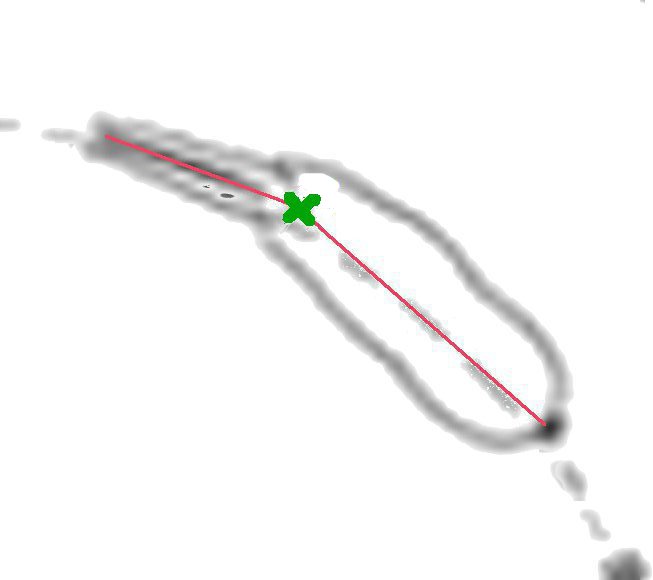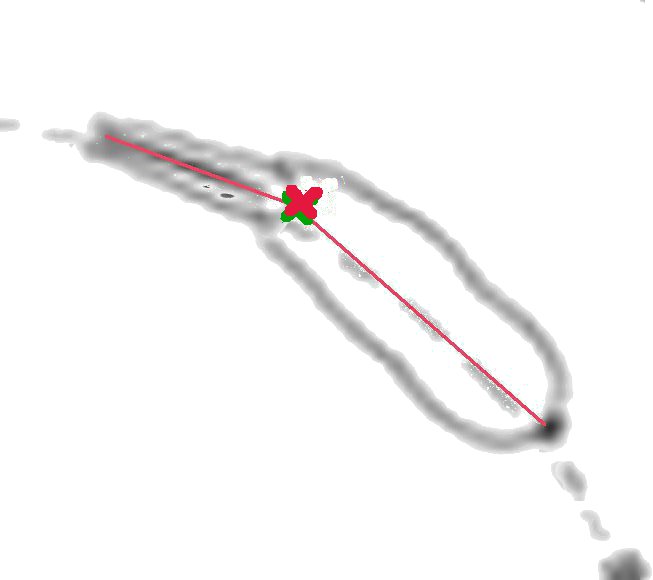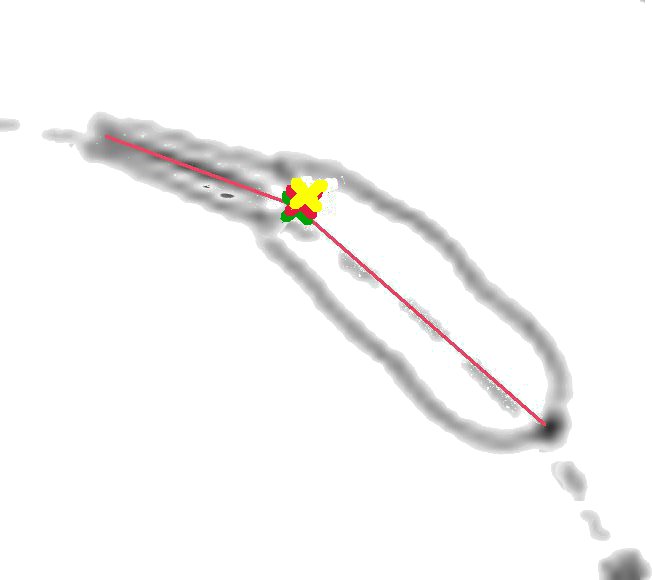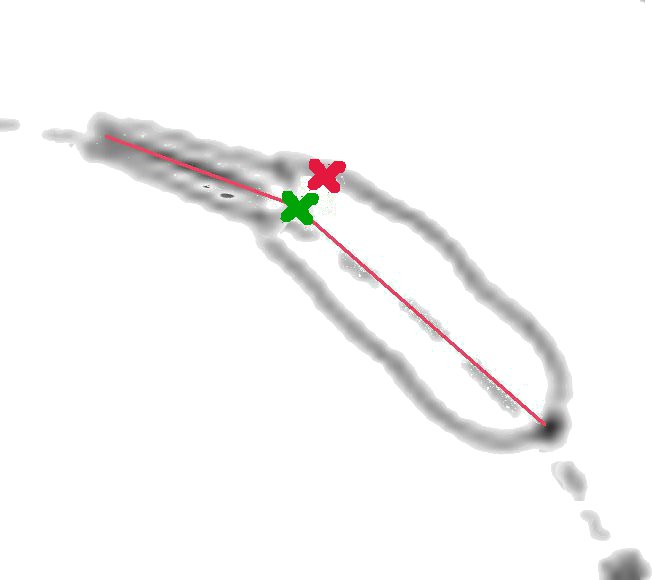All together now
As I'm coming around the circle, it occurs to me, not
all of my horse is coming around the circle! Some of
it is decidedly trying to leave! I have seen a similar
situation in riders that is particularly prevalent during
half pass. Theoretically, it's a half pass to the left
and both horse and rider are stepping to the left. In
reality, half the rider is fighting desperately to go
right. Sure, the outline of the horse and rider looks
like it's supposed to, but inside, something else is going
on. There is a discrepancy between the physical and
the mental, between the meal and the menu, so to speak.
The easiest way to learn about this is at the walk -
why? it's slow enough! The easiest place to
learn about this is on the circle - why? it corrects a lot
things at once and makes sense to the horse. (Although, as a side note, what I thought was a circle
when I was learning to ride is not the same thing I think a
circle is now!)
So, starting with the easiest thing, here's what you
do:
- Begin walking on a 20m(ish) circle. Bigger if you need to.
-
Your first task is to be aware of what is happening.
After that you can decide what action to take. To become aware of what is happening and start sorting this
all out, ask yourself:
- is the poll on the circle?
- is it 'wanting' to travel on the
circle?
- where does it 'want' to travel?
- is the point between the withers on the circle?
- is it 'wanting' to travel on the
circle?
- where does it 'want' to travel?
- is the sacroiliac joint on the circle?
- is it 'wanting' to travel on the
circle?
- where does it 'want' to travel?
- Now what to do about?
- If this is all you do, you've actually accomplished
a lot more than you may think. You've brought
awareness to yourself and your horse and *that alone*
will allow the self-corrective mechanisms to kick
in. Maybe not super-duper quick, but the
journey of a thousand miles starts with a single step,
and this was that step.
- There is also a technique you can use from
Ortho-bionomy which can help.
Those questions above bring into the conversation the concept of
vectors. Vectors are ways of describing speed and
direction together. Or, they're arrows of movement: Which way is something going?
Which way are the forces acting on it going? If you
pick up a ball and throw it, the ball is going in a
direction away from you. It's also got some up/down
direction and some forward direction which, when combined, produce
the direction it's going in. (and if you're really
clever, you can assign numbers to all of this!) (we're not
going to do that.)
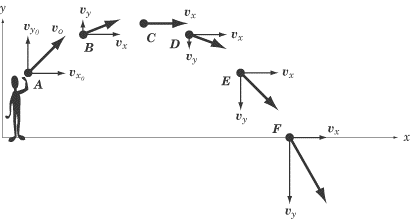
Riding a horse on a circle is more like winging a
tether ball around a pole. Because I'm a nerd, I'm
going to label these things correctly, but I'm also going to
name them according to how we ride.
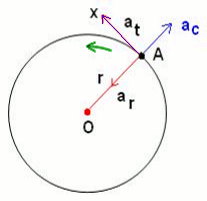
|
green
arrow |
path of movement |
path of movement - where we
want to go |
| at |
Tangential
Acceleration / Velocity / Inertia / Momentum |
where we'd most likely go
if we forgot we were riding a circle |
| ac |
Centrifugal
acceleration |
generated by our inside leg |
| ar |
Centripetal
acceleration or
Radial acceleration |
generated by our outside
leg and supporting outside rein and (hopefully) the
horse. |
|
|
|
The only thing that's really important here
is to realize there's more than one 'push' involved.
Some pushes are to the inside, some to the outside, some
forward, some sideways.... because it's a horse, we've
also got a lot of stuff going on inside. There's all
kinds of pushes and pulls generated by muscles leveraging
bones and working against the ground. (which we'll
talk about a bit later!) Sometimes
it helps to stop doing the thing that is causing the
problem. With horses, very often we end up chasing
after each new problem with a solution that creates another
problem. It can be helpful to stop all of
that.
| Problem |
Possible Rider Induced Causes |
Solution |
| Horse isn't going |
too much pulling back on the reins |
stop that! |
| Horse is 'falling out' |
outside rein is MIA |
provide support on outside rein |
|
outside rein is pulling horse to outside |
stop that! |
|
outside leg is MIA |
provide support with outside leg |
|
inside rein is pulling to inside and
horse is rebelling |
stop that! |
| Horse is 'falling in' |
outside rein is MIA |
provide support on outside rein |
|
inside rein is pulling horse to inside |
stop that |
|
inside leg is MIA |
provide support with inside leg |
|
outside rein is pulling to outside and
horse is rebelling |
stop that! |
Provided all your limbs are where they belong
providing support at the right time, the next thing to do is
figure out where your horse's body is wanting to go.
A very obvious case of this is asking the horse to go
to the right and it decides it wants to go left. It
can go left with it's head, it's shoulders, it's body, or
it's butt. Horses are very creative. You know it
wants to go the other way because there is an obvious pull
or drift in the direction it wants to go in and you're
perhaps not going where you want to go. A less obvious
case can involve any of the above but you're applying enough
force with legs and/or reins to counteract the horse and
keep it's feet on the circle. The trick is to get the
horse to carry itself where you want it to go!
I teach several different ways to resolve this.
If all you do is provide accurate feedback about what is
actually going on, you are helping to resolve things.
The
next easiest approach is based on Ortho-binoomy / Equine
Positional Release and involves accentuating the pattern. If I feel like the horse wants to throw its
head to the outside, I become aware of where the horse wants
to throw it's head to and pretend it's over there, and maybe
just a little more over there for good measure. Or if
it's the withers that don't want to be on the circle, I
pretend they're a little bit further away even.
When you're starting out, you can still
accomplish quite a bit by limiting yourself to the three major points along the
spine of poll, withers, and sacroiliac. Be observant of how
they relate to
the line of travel on a circle and you will find it helps
quit a bit.
Usually the horse will respond positively in about a minute.
For instance, this horse is tracking left and and the
poll and tail on are on the circle, but the withers are
habitually right of the circle. The green X is 'where
the shoulder point belongs.' The red X is 'where the
shoulder point is.' The yellow X is at the end of a
'vector' found by connecting the two and going just a little
bit beyond the red X and is where I pretend it is. I
'hold this thought' for perhaps a minute and then let it
go. In
reality, these distances are in inches usually.
For instance, this horse is tracking left on the
circle and I have the sense that it is throwing it's
shoulder to the right instead of tracking forward with it,
towards the circle. The
green X is 'where the shoulder point belongs.' The red
X is 'where the shoulder point wants to be.' The
yellow X is at the end of a 'vector' found by connecting the
two and going just a little bit beyond the red X and is
where I pretend it is. I 'hold this thought' for
perhaps a minute and then let it go. In reality, these distances can
be in feet, as in a foot or two or even like thirty.
Doing this for the three major points along the
spine - poll, withers, sacroiliac, and how they relate to
the line of travel on a circle, simple as it is, helps
quit a bit.
If you try it, let me know how it goes! And if
you'd like some hands on, call me up for a
lesson.
|




![Centered Riding Today: An Informal Talk by Sally Swift [VHS]](http://ecx.images-amazon.com/images/I/41Vn6PfhzML._SL125_.jpg)
![Centered Riding with Sally Swift [VHS]](http://ecx.images-amazon.com/images/I/51OSh9kd9iL._SL125_.jpg)


